
Comprehending
Composites
Keywords:
matrix,
strength,
thermoset,
toughness
First things first...a composite is any material made of more than one component. There are a lot of composites around you. Concrete is a composite. It's made of cement, gravel, and sand, and often has steel rods inside to reinforce it. Those shiny balloons you get in the hospital when you're sick are made of a composite, which consists of a polyester sheet and an aluminum foil sheet, made into a sandwich.
On this page we're going to talk mostly about polymer composites. Obviously we mean composites made from polymers, or from polymers along with other kinds of materials. But specifically we're going to deal with fiber-reinforced composites. These are materials in which a fiber made of one material is embedded in another material. Why would we do this? Let's find out...
Keeping Dry With Composites
I hate to disappoint you rock'n'rollers out there, but this section doesn't have anything to do with Polly Jean Harvey, although it does pertain to The Beatles, as you'll see if you keep reading. Anyway, let's talk about an example of one of the first fiber-reinforced polymer composites made by humans. Long ago, people living in South and Central America had used natural rubber latex, polyisoprene, to make things like gloves and boots, as well as rubber balls which they used to play games that were a lot like modern basketball. But if you've ever worn rubber gloves, you know that a raincoat made from rubber latex would be really uncomfortable. So sometime in the middle of the nineteenth century, a fellow by the name of Charles Macintosh came up with a clever idea...
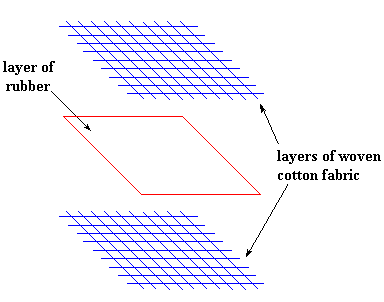 He took two layers of cotton fabric and embedded them in natural rubber, also known as polyisoprene, making a three-layered sandwich like the one you see on your right. (Remember, cotton is made up of a natural polymer called cellulose.) This made for good raincoats because, while the rubber made it waterproof, the cotton layers made it comfortable to wear. To this day, a raincoat in Great Britain is referred to as a "mackintosh", or just a "mack" for short, which is why in their song "Penny Lane", The Beatles sing, "And the banker never wears a mack/In the pouring rain, very strange."
He took two layers of cotton fabric and embedded them in natural rubber, also known as polyisoprene, making a three-layered sandwich like the one you see on your right. (Remember, cotton is made up of a natural polymer called cellulose.) This made for good raincoats because, while the rubber made it waterproof, the cotton layers made it comfortable to wear. To this day, a raincoat in Great Britain is referred to as a "mackintosh", or just a "mack" for short, which is why in their song "Penny Lane", The Beatles sing, "And the banker never wears a mack/In the pouring rain, very strange."
You see, that's why we make composites: to make a material that has the properties of both its components but joined to make the mixture even better. In this case, we combine the water-resistance of polyisoprene and the comfort of cotton.
Modern composites are usually made of two components, a fiber and matrix. The fiber is most often glass, but sometimes Kevlar, carbon fiber, or polyethylene. The matrix is usually a thermoset like an epoxy resin, polydicyclopentadiene, or a polyimide. The fiber is embedded in the matrix in order to make the matrix stronger. Fiber-reinforced composites have two things going for them. They are strong and light. They're often stronger than steel, but weigh much less. This means that composites can be used to make automobiles lighter, and thus much more fuel efficient. This means they pollute less, too.
What Fibers Do
A common fiber-reinforced composite is FiberglasTM. Its matrix is made by reacting a polyester with carbon-carbon double bonds in its backbone, and styrene. We pour a mix of the styrene and polyester over a mass of glass fibers.

The styrene and the double bonds in the polyester react by free radical vinyl polymerization to form a crosslinked resin. The glass fibers are trapped inside, where they act as a reinforcement.
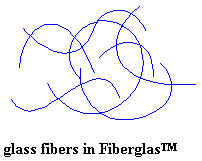
In FiberglasTM the fibers aren't lined up in any particular direction. They're just a tangled mass, like you see on the right. But we can make the composite stronger by lining up all the fibers in the same direction. Oriented fibers do some weird things to the composite. When you pull on the composite in the direction of the fibers, the composite is very strong. But if you pull on it at right angles to the fiber direction, it isn't very strong at all.

This isn't always bad, because sometimes we only need the composite to be strong in one direction. Sometimes the item you're making will only be under stress in one direction.
But sometimes we need strength in more than one direction. So we simply point the fibers in more than one direction. We often do this by using a woven fabric of the fibers to reinforce the composite. The woven fibers give a composite good strength in many directions.
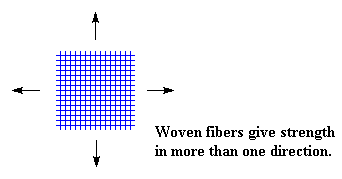
What the Matrix Does
But what about the matrix? We've talked about what fibers do for the matrix, but what does the matrix do for the fiber? Why not just use fibers by themselves? First of all, the matrix holds the fibers together. A loose bundle of fibers wouldn't be of much use. Also, though fibers are strong, they can be brittle. The matrix can absorb energy by deforming under stress. This is to say, the matrix adds toughness to the composite. And finally, while fibers have good tensile strength (that is, they're strong when you pull on them), they usually have awful compression strength. That is, they buckle when you squash them. The matrix gives compression strength to the composite.If you'd like to know more about just what it means to be strong and tough, and what the difference between strength and toughness is, visit our page dealing with the Mechanical Properties of Polymers.
Measuring up the Fibers
Not all fibers are the same. They all have good points and bad points. Glass is the most popular fiber. Why? Because it's really cheap. Now it may seem strange that glass is used as a reinforcement, as glass is really easy to break. I know this from years of destructive experience in the laboratory. But for some reason, when glass is spun into really tiny fibers, it acts very different. Glass fibers are strong, and flexible.As a matter of fact...You know those glass slippers that Cinderella wore to the ball? They weren't made of plain old glass. They were actually made from a glass fiber-reinforced composite material. I mean, think about it. Glass shoes? They'd break the first time Cindy stepped on a piece of gravel in the driveway of Prince Charming's palace! And even if they didn't they'd definitely shatter when the clumsy prince stepped on Cinderella's foot dancing. But slippers made from glass-reinforced composites would be strong enough to handle a stomp by the biggest royal foot!
Still, there are stronger fibers out there. This is a good thing, because sometimes glass just isn't strong and tough enough. For some things, like airplane parts, that undergo a lot of stress, you need to break out the fancy fibers. When cost is no object, you can use stronger, but more expensive fibers, like KevlarTM, carbon fiber, or SpectraTM. Carbon fiber is usually stronger than Kevlar®, that is, it can withstand more force without breaking. But KevlarTM tends to be tougher. This means it can absorb more energy without breaking. It can stretch a little to keep from breaking, more so than carbon fiber can. But SpectraTM, which is a kind of polyethylene, is stronger and tougher than both carbon fiber and KevlarTM.
Measuring up the Matrices
Different jobs call for different matrices. When we want to save money, there are some cheap matrices that have decent properties. The unsaturated polyester/styrene systems we've already looked at are one example. They're fine for everyday applications. Chevrolet Corvette bodies are made from composites using unsaturated polyester matrices and glass fibers. But they have some drawbacks. They shrink a good deal when they're cured, they can absorb water very easily, and their impact strength is low. They're also not very chemically resistant.
Another low-cost system is the so-called vinyl ester resin. The first step to making a vinyl ester resin is reacting a di-epoxide with acrylic acid, or methacrylic acid:
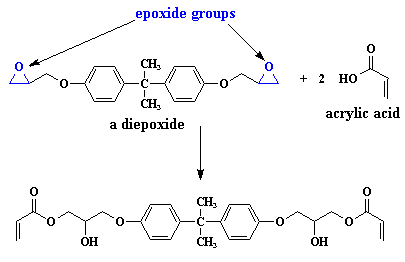
Then you polymerize the vinyl groups, and you've got a crosslinked resin. Sometimes we use bigger oligomers that look like this:

And they're cured the same way, by polymerizing the vinyl groups. Vinyl ester resins have some advantages over unsaturated polyesters. They don't absorb as much water, and they don't shrink nearly as much when cured. Plus, they have very good chemical resistance. Also, because of the hydroxyl groups, it bonds well to glass. This comes in handy if you're using glass as your fiber.
But neither vinyl ester resins nor unsaturated polyesters are very good for high temperature applications. For high temperatures, we need to use matrices like epoxy resins. To make these, we start with a di-epoxide, just like we did when we were making vinyl ester resins. Only this time, we don't react it with acrylic acid. Instead, we cure it with a diamine. The epoxide groups will react with the diamine, and the whole system becomes crosslinked:
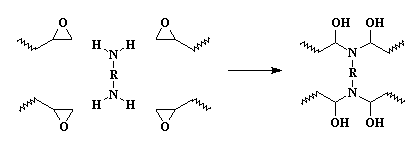
Because of all those hydroxyl groups, epoxy resins can bond well to glass fibers. But they have some properties you can't get with cheaper matrices. They don't absorb water, and they don't shrink very much when they're cured. And they can be used at higher temperatures, up to 160 oC in some cases.
But for REALLY high temperature applications, we're not sure what to do. There are a lot of options. Polyimides are good at resisting temperature, but they absorb a lot of water, which causes them to break down. Polybenzoxazoles are good at resisting temperatures, but they are almost impossible to process. Some people are interested in all-hydrocarbon matrices. Research is still underway in this field.
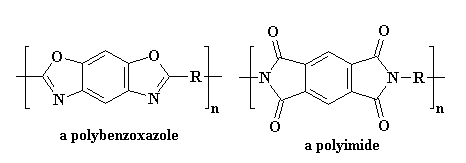
Most of the interest is in aerospace. There's a lot of interest right now in making a space-plane that can fly from Tokyo to Los Angeles in three hours. This plane would enter a low earth orbit during its flight. That means it would have to re-enter the atmosphere, and re-entry will generate a lot of heat on the surface of airplane. For the plane to make it through, it needs advanced composites that can stand up to the torture of all that heat.

|
Return to Level Three Directory |

|
Return to Macrogalleria Directory |